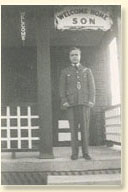

Welcome Home for Warrant officer Class 2 J.R. Hutchinson |
Life on the Homefront: Veterans and Veterans' Programmes
Canadians who had served in the military during the First World
War had a tough time after they returned home. The government had
prepared well for their care, with generous pensions, land schemes
and insurance policies, but the veterans got lost in the shuffle
and before long the government was questioning closely every claim
they made for help. Never again, said Canadians and their government. In June 1944
the government created the Department of Veterans Affairs to deal
with all matters affecting veterans and their dependents, principally
medical treatment; rehabilitation of the disabled (which included
special veterans' hospitals); education; insurance; welfare; allowances,
pensions and loans; and land settlement and housing. The Department
was at its busiest in 1947 dealing with returned service people.
It is still responsible for Canada's war veterans. Under the Veterans' Land Act, 1942, over 140,000 veterans sought
grants and loans to become full-time farmers, smallholders or commercial
fishermen. The Act was also used to purchase kitchen stoves, refrigerators
and washing machines for post-war households. Both the Act and Wartime
Housing Limited, a Crown company begun in 1941, provided inexpensive,
sturdy and permanent houses for returning veterans and the families
of those killed in the war. Veterans' programmes enabled some 50,000 young people to attend
university, crowding institutions right across the country; late
in the war, universities had had only about that number of students
all told. Temporary campuses, sometimes using abandoned wartime
factories or prefabricated barracks, were used to accommodate the
veteran-students. Carleton University in Ottawa was created mainly
to educate veterans. Related Newspaper Articles
English Articles
French Articles
-
Les pensions des soldats
Le Devoir, 24/01/1940
-
Création d'une 'Garde nationale d'anciens combattants' au Canada
Le Devoir, 24/05/1940
-
À Québec. Les succession des militaires. Le Bill Girouard
Le Devoir, 07/05/1941
-
Les fonctionnaires et l'enrôlement. Déclaration de M. Godbout
Le Devoir, 14/06/1941
-
Agents pour le bien-être des vétérans
Le Devoir, 04/08/1941
-
Pensions d'invalidité
Le Devoir, 22/10/1941
-
Pour les vétérans démobilisés. Le travail du major Léopold Ferland
Le Devoir, 29/01/1942
-
Le traitement que nous préparons aux vérétans de cette guerre-ci
Le Devoir, 26/03/1942
-
M.C.G. Power et les problèmes d'après-guerre
Le Devoir, 26/02/1943
-
Onze universités donneront le cours spécial de l'armée au Canada
Le Devoir, 12/04/1943
-
Les vétérans rétablis sans difficulté
Le Devoir, 05/07/1944
-
À l'hopital militaire de Ste-Anne-de-Bellevue
Le Devoir, 22/07/1944
-
"Lettre d'Ottawa. Gratification de $750,000,00 aux militaire pour services de guerre "
Le Devoir, 11/08/1944
-
M. King fait une revue des loi adoptées au profit des vétérans
Le Devoir, 17/08/1944
-
Nouvelles de guerre. Nos militaires désirent la sécurité pour l'après-guerre
Le Devoir, 06/09/1944
-
Les allocations pour service militaire
Le Devoir, 11/10/1944
-
McNaughton chez les vétérans
Le Devoir, 13/11/1944
-
École d'apprentissage et de réhabilitation
Le Devoir, 04/12/1944
-
Le rétablissement des vétérans
Le Devoir, 23/04/1945
-
"Collège "Kaki" pour les Canadiens"
Le Devoir, 14/05/1945
|